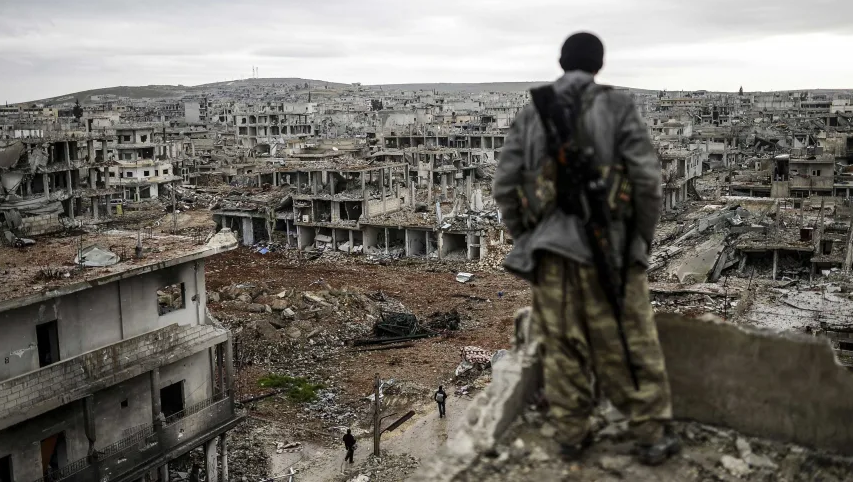HOSTILITIES REIGNITED IN GALILEE, SOUTHWEST SYRIA
TENTH ANNIVERSARY OF THE SYRIAN CIVIL WAR
A man stands atop a building looking at the destroyed Syrian town of Kobane,Syria, 2015. (Bulent Kilic, AFP, Getty Images).
A decade ago, as the Middle East was experiencing a political upheaval known as the Arab Spring, a large portion of the 22-million Syrian population decided the time was ripe to protest the oppressive Assad regime.
Ten years later, half a million have died (at least 12,000 of whom were children), 13.5 million have been displaced, thousands languish in appalling prisons, and tens of thousands are missing presumed dead. The remaining populations live in the chaos of a propped-up failing state, mass poverty and inflation, and overlapping proxy-wars with no end in sight.
How did we get from March 15, 2011 to today?
By March of 2011, Syria was on edge. A severe drought and rising unemployment had combined to foment unrest, and scenes of popular revolution in Tunis and Cairo were unnerving dictators across the Middle East. Although President Bashar al-Assad assured the media that his regime would not meet the same fate as that of Hosni Mubarak’ government in Egypt, in reality, he was sitting on a tinderbox. It was just a matter of when the proverbial match would strike into flame.
On March 6, a group of young boys between the ages of 10 and 15 spray-painted on the side of a wall and grain silo in the Southwestern town of Darra, a provincial capital near the border with Jordan. “As-Shaab / Yoreed / Eskaat el nizam!” or in English, “"The people / want / to topple the regime!" had become the slogan of the so-called Arab Spring uprisings that had begun sweeping across the Middle East and North Africa in January. The group of boys, all members of prominent tribal families in and around Darra, were rounded up by security forces and taken to a nearby detention facility, where they were interrogated and tortured for almost two weeks. This interrogation proved so severe that one of the boys died. On March 15th, a small group of 200 family members gathered in protest outside of the governor’s compound, demanding the release of their sons. Security forces opened fire on them, and then prevented ambulances from evacuating the wounded. The first victims of the Syrian Civil War were taken to a nearby mosque for treatment.
The protest movement continued to grow throughout March, as several unarmed protesters were killed in subsequent demonstrations, and a ruling Ba’ath Party office was set ablaze. Despite Assad’s assurances that justice would be served, followed by the subsequent release of the 15 boys, evidence of their torture only inflamed the crowds even further. Security forces allegedly under the command of Assad’s brother stormed the same mosque where the first victims were taken, which had since become a center of the revolution, killing several inside, including a doctor. The regime killings in the early days of the war began a pattern of murder, followed by angry funerals, followed by more protests, followed by more killing. In the first month, over 50 Syrians were shot dead by security forces, as Syrians in other cities began to march, chanting, “"With our souls, with our blood, we sacrifice to you Daraa."
While promising to raise salaries and lower taxes, Syrian President Bashar al-Assad also continued to employ the police, military and paramilitary forces to suppress public demonstrators with violence in the spring of 2011. As statues of Bashar and his late father Hafez began to topple across Syria, the regime used increasingly brutal tactics to quell dissent. Thousands of protesters who weren’t killed on the streets were often arrested and “disappeared” by security forces, taken to state-run detention facilities which had become efficient centers of torture and murder for the regime. Although Bashar and most of the senior figures in the government and security apparatus were adherents of the minority Alawite sect of Islam, members of Syria’s Sunni Muslim majority held many mid-level positions in the government, police and military. As the cycle of protest and violence continued through the summer, it began to take on distinctly sectarian tones. By October 2011, what began as a protest movement fully shifted to an armed uprising.
Though the initial protests of 2011 were mainly non-sectarian, dividing into those either pro- or anti-Assad, the opposition quickly split into smaller groups along factional lines. Some opposition groups are moderate and “pro-democracy,” with hopes that they will one day see Syria with a secular, representative government. However, many more of these groups are Sunni Muslim of varying extremism, angry at the atrocities of the Assad regime, as well as chafing under the rule of the Shia Alawite sect of the President and his Ba’athist ruling party. However, Sunni Muslims are the majority of the Syrian population, and many minorities (including Syrian Christians) fear Sunnis coming into power and losing the relative protection minorities experienced under the Assad regime. These are not baseless fears—another authoritarian government could be installed should opposition forces succeed in overthrowing Assad, and such a possibility prevents the international community from wholeheartedly supporting the Sunni opposition forces.
With the factions opposing the regime splitting due to various end goals, larger and larger parts of the country came under tentative control of opposition groups or were “no man’s land.” This vacuum of control facilitated the rise of the Islamic State in 2013 (known as IS, ISIS, ISIL, or Daesh), which was a disastrous development in a war that was already being fought on many fronts. This jihadist group, exploiting the chaos in Syria and its eastern neighbor Iraq, became a de facto state and a force to be reckoned with on an international level. By 2015, IS held territory that spanned from Mosul in Iraq almost all the way to Aleppo in Syria. At its peak, over ten million people lived under the brutal rule of IS.
The lightning-quick emergence of IS on the world stage brought in regional and international powers to the fighting fields of Syria in 2014, including a US-led anti-IS coalition. By the end of 2017, this coalition would include over 74 countries.
Russia also became involved in fighting what it termed “terrorists” in 2015, not as a member of the US-led coalition, but as a direct ally of the Assad regime. Russia did carry out airstrikes against IS, but it targeted opposition groups as well.
As IS lost more and more ground, it became clear that many regional and international actors had more than just the elimination of the jihadist group in mind, as Sunni and Shia proxy militias fought for strategic territory within Syria in order to advance their broader regional ambitions. As internal clashes between Syrian combatants have slowed, confrontations between external forces have escalated.
In 2016, Turkey, which borders Syria on its north, officially entered the fray. Though Ankara’s stated goal was to create a buffer zone along its southern border, it has captured significant ground in several military operations over the course of 2018 and 2019, and is currently occupying two large areas in Syria’s north.
By September 2018, the Assad regime had recaptured most of the major cities in Syria, aided by Russia and Iran-backed Shiite militias. Significant portions of the country were still held by opposition forces, Turkey, jihadis, the Kurdish-led Syrian Democratic forces, and a small portion is still controlled by the Islamic State.
When Coronavirus reached Syria in 2020, conflict conditions in Syria were frozen, marking the longest period of essentially static frontlines since the conflict began a decade ago in spring 2011. For the foreseeable future, life in Syria isn't going to improve from today's uneasy quiet. Russia and Iran got the outcome they wanted and now, burdened with COVID costs and Western sanctions, they have better things to spend money on than rebuilding Syria.
Europe and the United States will direct humanitarian assistance toward suffering Syrians, but they won't finance the reconstruction of a country led by Assad.
Right now, Syria’s future is bleak. Syria continues to be an area of chaos, war crimes, and proxy fights in the region, with no resolution or end in sight.
Maranatha family, pray for the people of Syria who are now suffering in the midst of a nightmare that doesn’t seem to end. On the one hand, they have a brutal regime, whose oppressive rule is not worth the “stability” it would bring. On the other hand, they live in total poverty, a third of the children have not been attending school for a decade, there is little to no civil infrastructure in many areas (police, medical, etc.) and the horrors of war are a daily reality. Thousands have been subject to detention and brutal torture, others have lost family to chemical weapons repeatedly used by the Assad regime. Pray also for wisdom for international leaders on how to hold the Assad regime accountable for the vast amount of war crimes and atrocities of which they are guilty, without pushing the country of Syria into total collapse. Pray for the teams at work in Syria, that they would be faithful witnesses and life-bringers in this dark and desperate place.
In Spring 2018, FAI Relief launched a labor and delivery clinic in an isolated and impoverished community in Syria. Serving this next generation of Syrians is a beautiful, hopeful, defiant answer to the carnage that surrounds them on a daily basis. It is our privilege to walk alongside people and provide an incarnate witness of an incarnate God.
If you’re burdened by the ongoing brutality within Syria’s borders and want to affect change that’ll last beyond tomorrow, we invite you to stand with us today.
Sources:
Why has the Syrian war lasted 10 years? - BBC News
10 years since start of Syrian civil war (aa.com.tr)
Syrian Civil War | Facts & Timeline | Britannica
How schoolboys began the Syrian revolution - CBS News
Why Is There a Civil War in Syria?- History.com
Ten Years Later, The Syrian Revolution is Not Over - Washington Post







